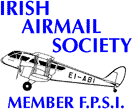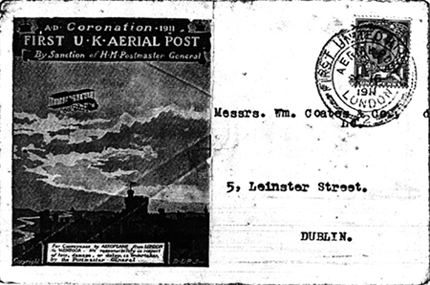 |
Airmail Society Publications Airmail Rates Latest Bulletin |
Home Irish Postal Censorship Related Philatelic Web Sites NetMind |
 |
Airmail Society Publications Airmail Rates Latest Bulletin |
Home Irish Postal Censorship Related Philatelic Web Sites NetMind |
Vol. 3 No. 4 - August 1993

by Alec Wright
------------------------------------------------------------
The world's first official scheduled airmail post was flown in the United Kingdom commemorating King George V's Coronation.
Capt. Windham, who conceived the idea, approached the Post Office for permission to run the service between London and Windsor. In 1911, Ireland was part of the United Kingdom of Great Britain and Ireland, so much interest was generated by the press in Ireland as well as on the mainland. We therefore see several acceptances to Ireland (fig 1 & 3). These include both the specially printed cards and covers.
Special postmarks and specially designed stationery was sold for use on this special flight. Pre-stamped postcards and envelopes retailed for 61/2d and 1/- respectively, for use in the UK and were sold through numerous well-known London stores. These stationery items are printed in various shades of yellow brown, brown, violet, olive green and red, and carry a design of Windsor Castle. It has been estimated that approximately 96,000 special postcards and 24,000 special envelopes were printed and sold. The violet cards and envelopes are the scarcest: they were only used for official invitations.
An unrecorded number of so called 'Emergency' envelopes exist. These had the special design printed onto already made up envelopes when the original stationery sold out (see front cover, fig 12 & 13). They are recognised by diagonal lines on the face of the covers where the folded seams on the back of the made-up envelope show through the printing on the front.
Special posting boxes were provided for the mail at several London stores and at Hendon and Windsor. Figure 4 shows the list of purchase and posting points on the back of the card. Persons who could not personally buy cards from the London stores could send payment to the Organising Committee, who would address the card to them with a special printed message (fig 4). There were no facilities to send registered mail and no known registered mail exists.
Numerous companies took advantage of the occasion to produce advertisements for their products and services, and generally these were on the reverse of the postcard (fig 2 & 6). However, a few com-panies, like The Molassine Company, printed an extra message on the obverse (fig 5). No complete records have been kept as to the numbers and different types of advertising cards produced, but approxi-mately two dozen different types have been recorded.
Four pilots were chosen to carry this mail -
C. Gresswell, G. Hamel, E. Driver and C. Hubert, but Hubert crashed his plane on his first flight during take off on September 11 and as a result was hospitalised for two months with two broken legs. The remaining three pilots carried all the mail and no substitute was sought.
Gustave Hamel was the pilot of the first flight that took place between London (Hendon Aerodrome) and Windsor, on Saturday 9 September 1911. This flight was scheduled for 3:30 p.m. but due to strong winds did not take place until 4:55 p.m. The whole operation was apparently hampered by bad weather and much mail was delayed: the backlog was not cleared until September 26.
A total of sixteen flights carried 37 bags of mail - 926 lbs. from London to Windsor and four flights carried 4 bags of mail - 89.5 lbs. from Windsor to London.
Although most of the mail was flown to destinations in England, Scotland and Wales, as mentioned, several items were sent to Ireland. Other destinations as far away as South Africa, New Zealand and Canada have also been recorded, and at least one envelope was sent to Switzer-land as illustrated in figure 12. After the flights the mail was circulated in the usual way.
The delivery time of some of the cards and covers is worth noting. The Irish mail was circulated in the 'inland service' via the Holyhead and Kingstown (Dun Laoghaire) packet. The Claremorris card took only three days, while the envelope to Louisburgh, Co. Mayo took 12 days, yet, only took one day to go back to Letterworth in England. The cover to Switzerland took seven days to reach its destination. Even by today's standards this was a very quick return time. However, most of us know that delivery is seldom up to that of former times despite, improvements in transport-ation, and mechanisation of most sorting operations. See figures 3, 9, 10 & 12.
All the cards posted from London to Windsor have a London to Windsor inscrip-tion on the bottom front of the cover. Windsor to London covers were similarly inscribed. However, a few envelopes and cards are known flown the wrong way (fig 13). The cancellation is dated Windsor, September 16, 1911, yet it is a London to Windsor card!
The approved special post-mark used solely on the Coronation Aerial Mails took was formed by two concentric circles between which are the words 'First United Kingdom' and within the inner circle the words 'Aerial Post' and the date and placename 'London' or 'Windsor.' The London postmark was used on six different dates: September 9, 11, 12, 13, 14, and 15. No mail was carried on Sunday 10, while heavy rain cancelled flights on Sept. 13 and 15. All Windsor mail sent by the public was postmarked Septem-ber 16, 1911, but there was a second flight on Sept. 18.
Publicity had been very high and generated much public interest, but the official view taken by the Post Office was: "an aeroplane is at present so dependant on the weather that it is practically useless as a means of ordinary and regular transport." Yet within thirty years, Britain became the largest carrier of external air mail in the world, carrying up to three tons of mail around the Empire, including that from Ireland.
Thanks to Ronny Vogt, Karl Winkelmann, Myron Hill Jr., Stephen Reinhard and Bill Murphy, for some of the illustrations and extra information.